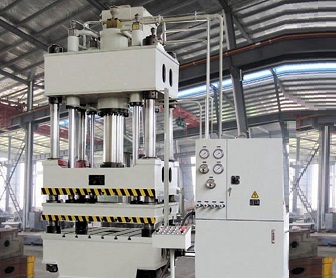
200/300 Ton Hydraulic Press for LPG Cylinder Deep Drawing
Long service life,simple and convenient operation,high production efficiency. The machine adopts the computer optimization structure design, the structure is simple, economical and practical. The machine, electricity and liquid integrated safety device,programmable logic controller,has the advantages of sensitive and reliable work.
Technology parameters:
1.Blank-hold force 1000KN
2.Stretching force 2000KN
3.Power of motor 44KW
4.The maximum piston travel of slider 700mm
5.The maximum stroke of blank holder slide 400mm
6.Effective area of worktable 1000×900mm2
7.Weight 12 Ton
Main characteristics of four columns hydraulic press:
--Computer optimized design,3-beam & 4-column structure,easy ,utility
--Cartridge valves widely used for hydraulic system, reliable, durable and less hydraulic impact
--Independent electrical control system, reliable, audio-visual and convenient for maintenance
--Button centralized control:adjusting,semi-auto
--Operation panel:constant stroke & pressure,with pressure holding and time delay functions.
--Stroke and pressure is adjustable according practical use.
Options :
Moving table
Cutting dampening system
Light curtain safety device
Displacement/pressure sensor
Programmable logic controller (PLC)
Industry touch screen
Air cooling/water cooling/industry chiller
Die exchange cart
Floating guide way & rolling bracket for die exchange
Quick die clamping device
Electrical /oil heating device
Working area lighting
Power socket
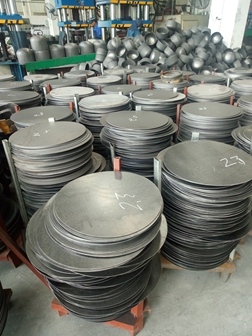
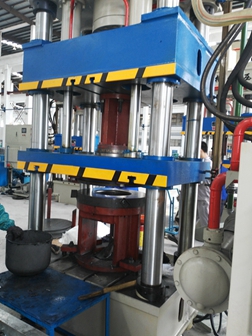
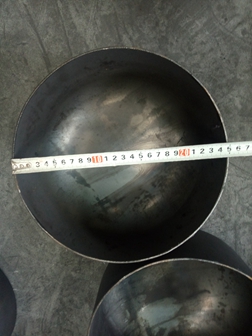

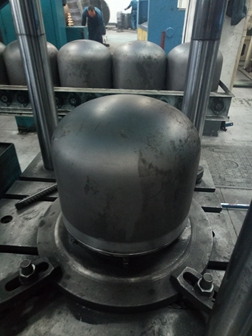
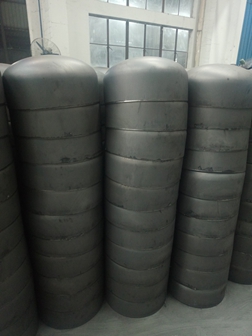
Deep drawing is a manufacturing process used in the production of steel LPG (liquefied petroleum gas) cylinders. This process involves the conversion of flat sheets or blanks of steel into cylindrical shapes.
An overview of the deep drawing process in the context of manufacturing steel LPG cylinders:
Material Preparation:
The process begins with the preparation of flat sheets of steel, usually in the form of coils.The steel used for LPG cylinders must meet specific material and thickness requirements to ensure the final product's strength and safety.
Blanking:
Blanking involves cutting the flat steel sheets into circular blanks, which will be used to form the body of the cylinder.These blanks are typically larger than the final cylinder dimensions to account for material stretching during the deep drawing process.
Drawing Operation:
The deep drawing machine, which consists of a punch and die set, is employed to form the cylindrical shape.The circular blank is placed over the die, and the punch descends,the steel blank undergoes plastic deformation, stretching and thinning to take on the shape of the cylinder,this semi-finished half of cylinder also called dome of cylinder.
In the deep drawing process for steel LPG cylinder manufacturing, a hydraulic press plays a crucial role in forming the metal blanks into the desired cylindrical shape.
Hydraulic Press Overview:
A hydraulic press is a machine that uses hydraulic fluid to generate compressive force. It typically consists of a hydraulic cylinder and a hydraulic pump system.
Die and Punch Setup:
In the context of deep drawing for LPG cylinder manufacturing, a die and punch set is mounted on the hydraulic press.The die is a stationary component, and the punch is attached to the hydraulic ram or piston. The die and punch together define the shape that the steel blank will take during the deep drawing process.
Loading the Blank:
A flat steel blank, often in the form of a circular sheet, is placed over the die.
Blank Holding:
Before the deep drawing process begins, the hydraulic press exerts a force to hold the blank against the die to prevent it from moving during the initial stages of the operation.
Deep Drawing Operation:
The hydraulic press is activated, and the hydraulic cylinder pushes the punch downward into the die.The force applied by the hydraulic press causes the steel blank to deform and take the shape of the die, resulting in the formation of the cylindrical body of the LPG cylinder.The deep drawing process is characterized by plastic deformation, where the material stretches and conforms to the shape of the die.
Blanking:
The metal sheet blanking process is a crucial step in the manufacturing of steel LPG (liquefied petroleum gas) cylinders. Blanking involves cutting flat metal sheets into circular blanks, which will serve as the starting material for the subsequent deep drawing process.
An overview of the metal sheet blanking process in LPG cylinder manufacturing:
Material Selection:
The manufacturing process begins with the selection of suitable steel sheets. The chosen material should meet specific requirements regarding thickness, strength, and other mechanical properties to ensure the safety and reliability of the final LPG cylinders.Generally, HP295 grade steel coil materials are selected.
Coil Unrolling (must be applicable):
In some cases, steel is supplied in the form of coils. If this is the case, the coil is unrolled to obtain flat sheets.
Sheet Cutting (Blanking):
The flat metal sheets are then cut into circular blanks using a hydraulic press with a die-cutting process.The circular blanks are cut to a size larger than the final dimensions of the LPG cylinder. This oversize accounts for material stretching during the deep drawing process.
Scrap Removal:
After cutting, there may be leftover material or scrap around the edges of the circular blanks. This excess material, known as "trim" or "scrap," is typically removed and recycled.
Quality Control:
The cut blanks undergo quality control checks to ensure they meet the specified dimensions and material properties.Any blanks that do not meet the quality standards may be rejected to maintain the integrity and safety of the LPG cylinders.
Stacking and Storage:
The approved blanks are then stacked and stored, ready for the subsequent deep drawing operations.Stacking is done carefully to prevent damage to the blanks and to maintain order in the manufacturing process.
The metal sheet blanking process is a preparatory step that provides the raw material in the form of circular blanks for the deep drawing process. It allows for efficient mass production by starting with uniform pieces that can be consistently formed into LPG cylinders. The precision and quality of the blanking process significantly impact the overall manufacturing process and the final product's safety and performance.
Hydraulic press:
In the metal sheet blanking process for steel LPG cylinder manufacturing, a hydraulic press is typically the primary equipment used for the blanking operation,hydraulic punch press is commonly employed,these presses are specifically designed for high-speed cutting or punching of sheet metal. It's important to note that the hydraulic press is more commonly associated with the deep drawing process in LPG cylinder manufacturing, as it provides the gradual and controlled force required for shaping the metal blanks into the cylindrical form. The metal sheet blanking process, being a cutting operation, often involves punch presses that are optimized for high-speed and efficient cutting of flat sheets into circular blanks.
In many manufacturing processes, including sheet metal operations, there can indeed be a combination of mechanical and hydraulic systems in a single machine. This type of press is often referred to as a "hydraulic-mechanical press" or "hydraulic press brake."
These hybrid presses provide manufacturers with the advantages of both mechanical and hydraulic systems, offering flexibility and efficiency across different stages of the manufacturing process. The selection of a particular type of press or a combination depends on factors such as the nature of the operation, material characteristics, required precision, and production volume.
In the context of metal sheet blanking for LPG cylinder manufacturing, a hydraulic-mechanical press or a combination of mechanical and hydraulic presses may be used to efficiently cut the flat sheets into circular blanks with the necessary speed and precision.We also call this combination of devices as hydraulic press.
Summary:
In the context of steel LPG cylinder manufacturing, hydraulic equipment can be used in both the metal sheet blanking and deep drawing processes. However, the specific type and configuration of the hydraulic equipment may vary to suit the requirements of each process.
In metal sheet blanking, a hydraulic press or hydraulic punch press may be employed to cut flat sheets into circular blanks efficiently. The hydraulic system allows for controlled force application and is well-suited for tasks that require precision cutting.
In the deep drawing process, a hydraulic press is commonly used to form the cylindrical shape of the LPG cylinder. This hydraulic press provides the gradual and controlled force necessary to shape the metal blank into the desired three-dimensional form.
So, while both processes involve hydraulic equipment, the design and configuration of the hydraulic systems might be tailored to the specific needs of each operation. The key is that hydraulic systems offer flexibility, precision, and control, making them suitable for various stages of metal forming and fabrication in LPG cylinder manufacturing.








